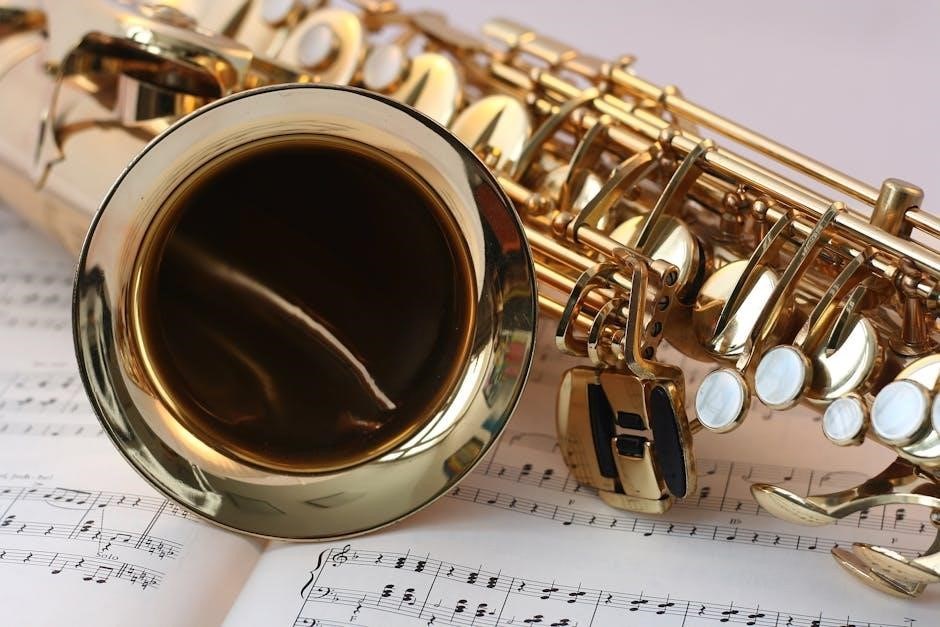A saxophone mouthpiece is a vital component that significantly impacts sound quality, playability, and comfort․ This guide explores key factors, types, and tips to help you find the perfect mouthpiece for your needs․
Importance of Choosing the Right Mouthpiece
Selecting the right saxophone mouthpiece is crucial for achieving optimal sound quality, playability, and comfort․ A well-suited mouthpiece enhances tone, intonation, and responsiveness, while a poor choice can hinder performance and cause discomfort․ It directly impacts embouchure development and breath control, especially for beginners․ Additionally, the mouthpiece affects reed compatibility and overall playing ease․ A mismatched mouthpiece can lead to pitch inaccuracies, fatigue, and frustration․ Therefore, understanding your needs and preferences is essential to make an informed decision, ensuring a enjoyable and effective playing experience․
- Affects sound quality and intonation․
- Influences playability and comfort․
- Impacts embouchure and breath control․
- Ensures proper reed compatibility․
Understanding Saxophone Mouthpiece Types
Saxophone mouthpieces vary in design, material, and size to suit different saxophones and playing styles․ Each type is crafted to deliver distinct tonal qualities and playability characteristics․
Differences Between Soprano, Alto, Tenor, and Baritone Mouthpieces
Soprano, alto, tenor, and baritone saxophones each require mouthpieces tailored to their unique characteristics; Soprano mouthpieces have smaller tip openings for brighter, higher-pitched tones, while alto mouthpieces balance playability and versatility․ Tenor mouthpieces are larger, offering a rich, full-bodied sound, and baritone mouthpieces are the largest, designed for deeper, warmer tones․ Material options like plastic, metal, and hard rubber further distinguish them, with metal producing bold, projecting sounds and hard rubber offering a smoother, more traditional feel․ Each type is crafted to meet the specific demands of its saxophone, ensuring optimal performance and tonal quality for musicians across all skill levels․
Material Options: Plastic, Metal, and Hard Rubber
Saxophone mouthpieces are available in plastic, metal, and hard rubber, each offering distinct tonal and playability characteristics․ Plastic mouthpieces are durable, lightweight, and ideal for beginners, providing a bright, clear sound․ Metal mouthpieces are favored by advanced players for their bold, projecting tones and resonance․ Hard rubber mouthpieces strike a balance, delivering a smooth, warm sound with excellent responsiveness․ The choice of material depends on the player’s skill level, musical style, and personal preference, ensuring a tailored fit for optimal performance and comfort․

Factors to Consider When Choosing a Saxophone Mouthpiece
Sound quality, playability, and comfort are key factors․ Consider tip opening size, material type, and skill level to ensure the best fit for your musical needs․
Tip Opening Size and Its Impact on Playability
Tip opening size, measured as the distance between the reed and mouthpiece tip, greatly affects playability․ A smaller tip opening, like the Yamaha 4C, offers easier control and is ideal for beginners, requiring less air pressure․ Conversely, larger tip openings suit advanced players seeking a fuller, richer sound․ Proper balance between tip size and reed strength is crucial; smaller tips pair well with harder reeds, while larger tips work best with softer reeds․ This balance ensures optimal tone quality and ease of playability, making it essential to choose a tip opening that matches your skill level and musical goals․
The Role of Skill Level in Mouthpiece Selection
Skill level plays a crucial role in mouthpiece selection, as different features cater to various player abilities․ Beginners benefit from mouthpieces with smaller tip openings, such as the Yamaha 4C, which are more forgiving and easier to control․ Intermediate players may transition to medium tip openings for improved tone and responsiveness․ Advanced players often prefer larger tip openings, offering greater dynamic range and articulation․ Additionally, factors like baffle type and material vary with skill level, as more experienced players may seek specific tonal characteristics․ Selecting a mouthpiece that aligns with one’s skill level ensures a better playing experience and supports technical development․
Baffle Types: Flat, Rollover, and Step Baffles
The baffle is a critical feature of a saxophone mouthpiece, influencing tone, intonation, and response․ A flat baffle provides a bright, direct sound with good articulation, often preferred by classical players․ Rollover baffles offer a smoother, warmer tone and better intonation, making them ideal for jazz and ensemble settings․ Step baffles, more complex in design, deliver a brighter, edgier sound with increased projection, typically favored by advanced players․ Each baffle type suits different musical styles and player preferences, allowing for customization of the saxophone’s sound and feel;

Popular Saxophone Mouthpiece Brands and Models
Top brands include Yamaha, Meyer, Otto Link, Vandoren, and Jody Jazz․ Models like Yamaha 4C, Meyer 5M, and Vandoren T7 are favorites for their tone and playability․
Yamaha 4C: A Beginner-Friendly Option
The Yamaha 4C mouthpiece is a top choice for beginners due to its ease of playability and consistent tone․ Designed with a narrow tip opening, it reduces air resistance, making it easier for new players to produce a clear, rich sound․ Its durable construction ensures longevity, and it pairs well with softer reeds, providing a forgiving experience․ Many educators recommend the 4C, as it helps build proper embouchure and breathing techniques․ Whether for alto or tenor sax, the Yamaha 4C is a reliable starting point for those developing their skills․
Meyer and Otto Link: High-Quality Choices for Advanced Players
Meyer and Otto Link mouthpieces are renowned for their exceptional craftsmanship and rich tonal quality, making them favorites among advanced saxophonists․ Meyer mouthpieces, such as the 5M and 6M, are particularly popular for alto sax, offering a balanced and projecting sound․ Otto Link, known for its vintage-inspired designs, is highly regarded for tenor sax, delivering a warm, full-bodied tone․ Both brands cater to experienced players seeking precise control and nuanced expression․ Their facings and chamber designs allow for versatility, accommodating a variety of musical styles․ For those looking to elevate their performance, Meyer and Otto Link provide high-end options that meet the demands of advanced play․
Mouthpiece Maintenance and Care
Regular cleaning and sanitizing are crucial for maintaining your saxophone mouthpiece․ Adjust the cork for a proper fit to ensure optimal performance and prevent damage over time․
Cleaning and Sanitizing Your Mouthpiece
Regularly clean and sanitize your saxophone mouthpiece to maintain hygiene and prevent bacterial growth․ Use mild soap and warm water, avoiding harsh chemicals that could damage materials․ Gently brush the chamber and tip opening to remove residue․ Sanitize with a solution of equal parts water and white vinegar, then rinse thoroughly․ For deeper cleaning, soak the mouthpiece in warm soapy water for about 15 minutes․ Always dry thoroughly to prevent moisture buildup․ Proper care ensures optimal performance and longevity of your mouthpiece, while maintaining a clean and healthy playing environment․
Adjusting the Cork for Proper Fit
Properly fitting the cork on your saxophone mouthpiece is crucial for a secure connection and optimal performance․ If the mouthpiece feels too tight or loose on the neck, the cork may need adjustment․ Use fine-grit sandpaper to gently remove cork material, testing the fit frequently․ Avoid over-sanding, as this can cause instability․ Apply a small amount of cork grease to ensure smooth insertion without sticking․ A well-adjusted cork ensures even airflow, preventing leaks and maintaining consistent tone quality․ Regular checks and minor adjustments will help maintain the mouthpiece’s performance and overall playability over time․

Reed and Mouthpiece Compatibility
Matching reed strength with mouthpiece tip opening ensures balanced playability and tone․ Smaller tip openings pair best with harder reeds, while larger tips suit softer reeds․
Matching Reed Strength with Tip Opening Size
Properly matching reed strength with mouthpiece tip opening size is crucial for optimal playability and sound quality․ A smaller tip opening pairs well with harder reeds, ensuring a balanced tone and easier control․ Conversely, larger tip openings work best with softer reeds, providing a richer, fuller sound․ For example, a Yamaha 4C mouthpiece with a tip opening of 4 is often paired with a 2 reed, ideal for beginners․ Experimenting with different combinations helps find the perfect harmony between reed strength and tip size, enhancing clarity and resonance․ This balance is essential for achieving a clear, responsive sound across all saxophone types․

A Beginner’s Guide to Saxophone Mouthpieces
Starting with a forgiving mouthpiece is essential for beginners․ Yamaha’s 4C is a popular choice, offering a narrow tip opening that makes playing easier and more comfortable․
Starting with Forgiving Mouthpieces for Beginners
Forgiving mouthpieces are ideal for beginners, as they offer easier playability and a more comfortable learning curve․ The Yamaha 4C mouthpiece is highly recommended, featuring a narrow tip opening of 4, which simplifies blowing and reduces air pressure․ This design allows new players to focus on developing proper embouchure and breath control without unnecessary strain․ Additionally, pairing the 4C with a softer reed, such as a 2 strength, helps ensure a smoother transition into playing the saxophone․ Starting with such a setup enables beginners to build confidence and improve their technique effectively from the very beginning․



